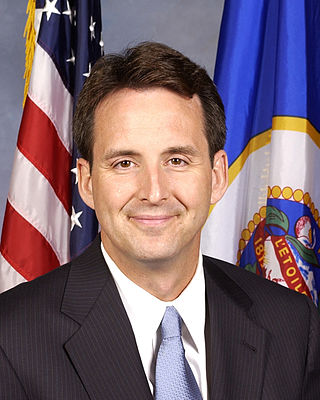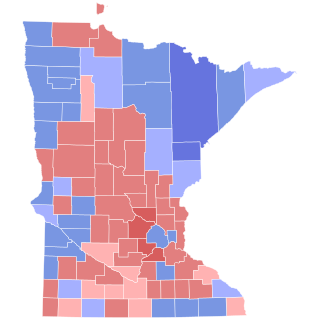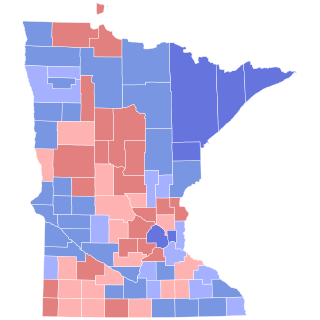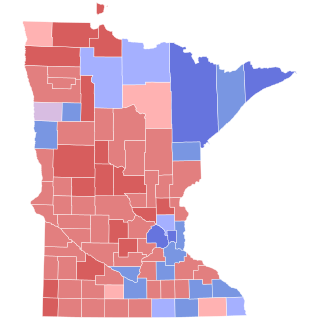
Mark Brandt Dayton is an American politician who served as the 40th governor of Minnesota from 2011 to 2019. He served as a United States Senator representing Minnesota from 2001 to 2007 and as Minnesota State Auditor from 1991 to 1995. He is a member of the Minnesota Democratic–Farmer–Labor Party (DFL), which affiliates with the national Democratic Party.

Rodney Dwight Grams was an American politician and television news anchor who served in both the United States House of Representatives and the U.S. Senate. A local news anchor, Grams became well-known for working at Twin Cities station KMSP-TV from 1982 until 1991. He was a member of the Republican Party.

The 2006 Minnesota gubernatorial election took place on November 7, 2006. Incumbent Tim Pawlenty was endorsed by the state Republican convention on June 2, 2006, while the state Democratic–Farmer–Labor convention endorsed Mike Hatch on June 10, 2006. The party primaries took place on September 12, 2006, with Hatch defeating DFL challengers Becky Lourey and Ole Savior and incumbent Pawlenty defeating Sue Jeffers. In the November 7 general election, Pawlenty received a plurality of the votes, defeating Hatch by a margin of 1%. As a result, this election was the closest race of the 2006 gubernatorial election cycle.

The 2006 United States Senate election in Minnesota took place on November 7, 2006. Incumbent Senator Mark Dayton announced in February 2005 that he would retire instead of seeking a second term. Fellow Democrat Amy Klobuchar won the open seat by 20.2 percentage points. Primary elections took place on September 12, 2006.

The 2002 Minnesota gubernatorial election took place on November 5, 2002 for the post of Governor of Minnesota. Republican candidate Tim Pawlenty defeated Democratic candidate Roger Moe and Independence Party of Minnesota candidate Tim Penny. Due to personal reasons regarding the health of his spouse, incumbent Governor Jesse Ventura chose not to seek re-election. Pawlenty comfortably won the election, which was attributed in part to Moe's uninspired campaign, with Moe being dubbed a "cautious dullard" four years later by the City Pages.

The 2004 United States presidential election in Minnesota took place on November 2, 2004 as part of the 2004 United States presidential election. Voters chose ten representatives, or electors to the Electoral College, who voted for president and vice president.

The 2002 United States Senate election in Minnesota took place on November 5, 2002. Incumbent Senator Paul Wellstone was running for a third term but died in a plane crash eleven days before the election. The Democratic–Farmer–Labor Party (DFL) quickly chose former Vice President and 1984 presidential nominee Walter Mondale to replace Wellstone on the ballot. Mondale had previously held the seat from 1964 to 1976, resigning to assume the vice presidency. He narrowly lost to Republican Norm Coleman, the former mayor of Saint Paul. The day before the election, Governor Jesse Ventura appointed the 1996 Independence Party candidate, Dean Barkley, to serve the remainder of Wellstone's term.

The 2008 United States presidential election in Minnesota took place on November 4, 2008, and was part of the 2008 United States presidential election. Voters chose ten representatives, or electors to the Electoral College, who voted for president and vice president.

The 2000 United States presidential election in Minnesota took place on November 7, 2000, as part of the 2000 United States presidential election, which was held throughout all 50 states and D.C. Voters chose ten representatives, or electors to the Electoral College, who voted for president and vice president.
Elections were held in Minnesota on Tuesday, November 2, 2010. Primary elections took place on August 10, 2010.

The 2012 United States Senate election in Minnesota took place on November 6, 2012, concurrently with the U.S. presidential election as well as other elections to the United States Senate and House of Representatives as well as various state and local elections. Incumbent Democratic–Farmer–Labor U.S. Senator Amy Klobuchar faced Republican State Representative Kurt Bills. Klobuchar was reelected in a landslide, defeating Bills by almost one million votes and carrying all but two of the state's 87 counties by double digits. This election marked the first time since 1996 that an incumbent Democratic senator was re-elected and the first time since 1976 that an incumbent Democratic senator was re-elected to this seat.

The 2012 United States presidential election in Minnesota took place on November 6, 2012, as part of the 2012 United States presidential election in which all 50 states plus the District of Columbia participated. State voters chose ten electors to represent them in the Electoral College via a popular vote pitting incumbent Democratic President Barack Obama and his running mate, Vice President Joe Biden, against Republican challenger and former Massachusetts Governor Mitt Romney and his running mate, Congressman Paul Ryan.

The 2006 congressional elections in Minnesota were held on November 7, 2006 to determine who would represent the state of Minnesota in the United States House of Representatives.

The 2014 Minnesota gubernatorial election took place on November 4, 2014, to elect the governor of Minnesota concurrently with the election to Minnesota's Class II U.S. Senate seat, as well as other elections to the United States Senate in other states and elections to the United States House of Representatives and various state and local elections.

The 2014 United States Senate election in Minnesota was held on November 4, 2014, to elect a member of the United States Senate to represent the State of Minnesota, concurrently with the election of the Governor of Minnesota, as well as other elections to the United States Senate in other states and elections to the United States House of Representatives and various state and local elections.
A general election was held in the U.S. state of Minnesota on November 4, 2014. All of Minnesota's executive officers were up for election as well as all the seats in the Minnesota House of Representatives, several state judicial seats, a United States Senate seat, all of Minnesota's eight seats in the United States House of Representatives, and several seats for local offices. A primary election was held on August 12, 2014, to nominate major political party candidates for partisan offices and candidates for nonpartisan offices.

The 1972 United States presidential election in Minnesota took place on November 7, 1972, as part of the 1972 United States presidential election. Voters chose ten electors, or representatives to the Electoral College, who voted for president and vice president.

The 2018 Minnesota gubernatorial election took place on November 6, to elect the 41st Governor of Minnesota as incumbent Democratic governor Mark Dayton chose not to run for re-election for a third term. The Democratic nominee was congressman Tim Walz from Minnesota's 1st congressional district while the Republicans nominated Hennepin County commissioner Jeff Johnson. The Independence Party of Minnesota didn't field a candidate for the first time since 1994. Going into the election the polls showed Walz ahead and the race was characterized as lean or likely DFL.
A general election was held in the U.S. state of Minnesota on November 6, 2018. All of Minnesota's executive officers were up for election as well as all the seats in the Minnesota House of Representatives, several judicial seats, two United States Senate seats, Minnesota's eight seats in the United States House of Representatives, and several seats for local offices. Special elections were also held for a Minnesota Senate seat and Minnesota's Class 2 U.S. Senate seat. A primary election to nominate Republican and Democratic–Farmer–Labor (DFL) candidates and several judicial and local primary elections were held on August 14, 2018.

The 2018 United States Senate special election in Minnesota took place on November 6, 2018, to elect a United States senator from Minnesota to replace incumbent Democratic senator Al Franken until the regular expiration of the term on January 3, 2021. Facing multiple accusations of sexual misconduct, Franken announced on December 7, 2017, that he would resign effective January 2, 2018. Governor Mark Dayton appointed Franken's successor, Tina Smith, on December 13, 2017, and she ran in the special election. This election coincided with a regularly scheduled U.S. Senate election for the Class 1 Senate seat, U.S. House elections, a gubernatorial election, State House elections, and other elections.





















